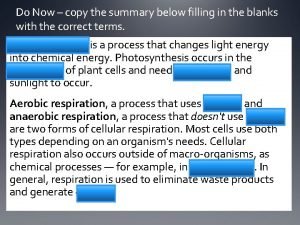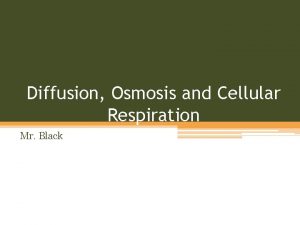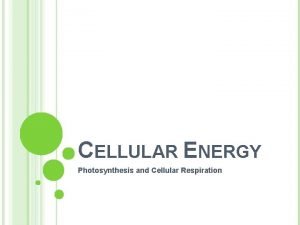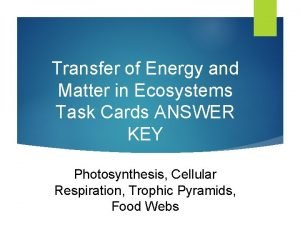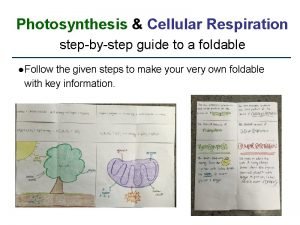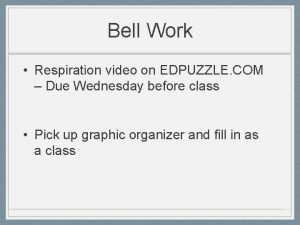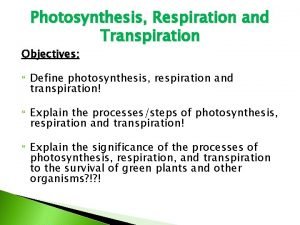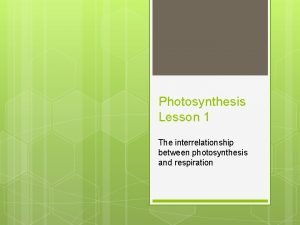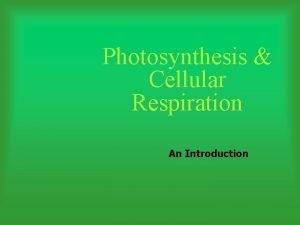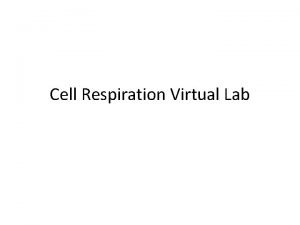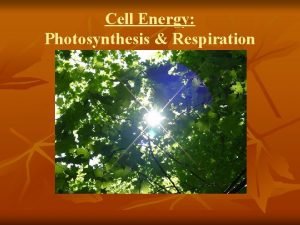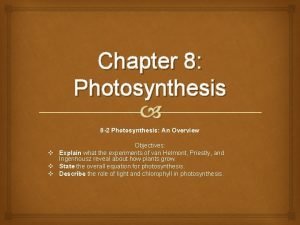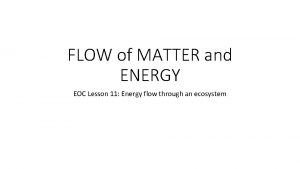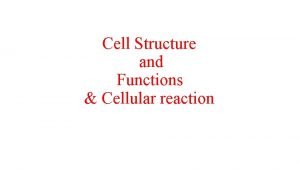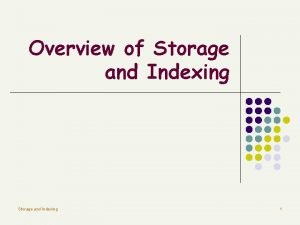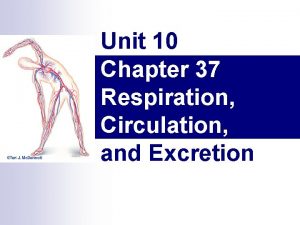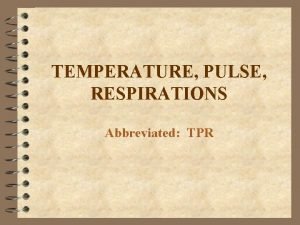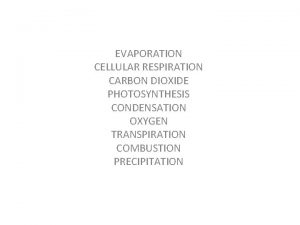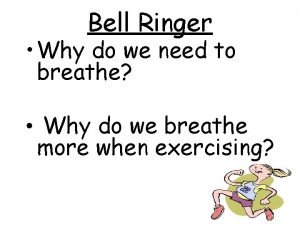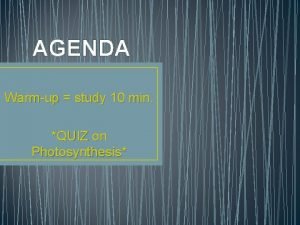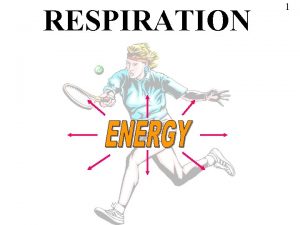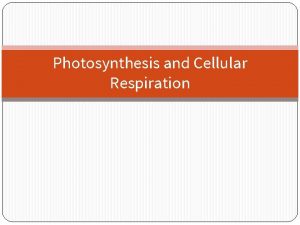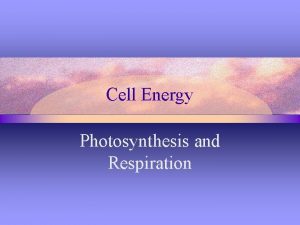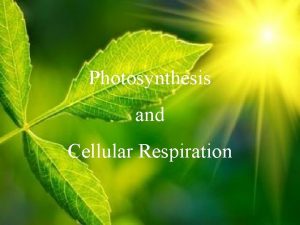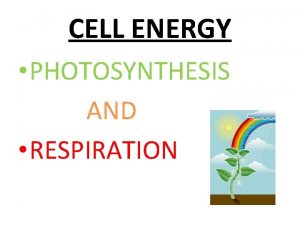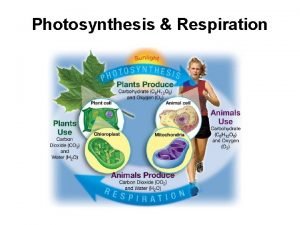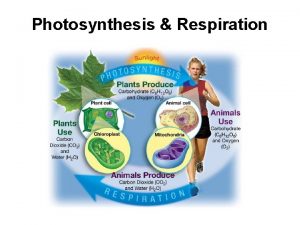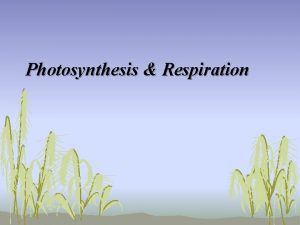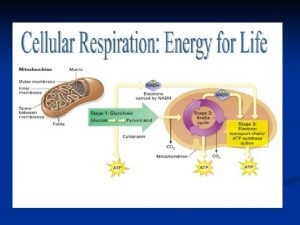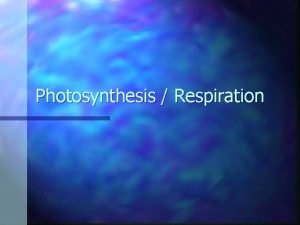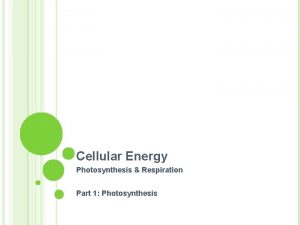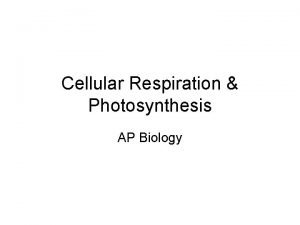Photosynthesis Respiration Overview of photosynthesis and respiration SUN








































- Slides: 40

Photosynthesis & Respiration

Overview of photosynthesis and respiration SUN RADIANT ENERGY PHOTOSYNTHESIS GLUCOSE RESPIRATION ATP(ENERGY) CELL ACTIVITIES

EQUATION FOR PHOTOSYNTHESIS WATER 6 CO 2 + 6 H 2 O + ENERGY CARBON DIOXIDE OXYGEN C 6 H 12 O 6 + GLUCOSE 6 O 2

EQUATION FOR RESPIRATION CARBON DIOXIDE GLUCOSE C 6 H 12 O 6 + 6 O 2 OXYGEN ATP 6 CO 2 + 6 H 2 O + ENERGY WATER

What is Photosynthesis? The process of photosynthesis is a chemical reaction. It is the most important chemical reaction on our planet.

What is the Equation for the Chemical Reaction of Photosynthesis?

What is the equation for the chemical reaction of photosynthesis?

What is the equation for the chemical reaction of photosynthesis? Six molecules of carbon dioxide react with six molecules of water to form 1 molecule of glucose and six molecules of oxygen.

Describe Photosynthesis

Describe Photosynthesis • The process of changing light energy to chemical energy • Energy stored as sugar • Occurs in plants and some algae • Plants need light energy, CO 2, and H 2 O • Takes place in the chloroplasts, using chlorophyll, the green pigment in plants

http: //www. slideshare. net/sbishop 2/b 23 photosynthesis

What happens during photosynthesis? https: //coordinatedscience 1. wordpress. com/lessons/unit-5 energy-in-plants-and-animals/5 -2 -the-leaf-and-photosynthesis/




What happens during photosynthesis? • Plants capture light energy and use that energy to make glucose • Sunlight provides the energy needed by chlorophyll to change molecules of carbon dioxide and water into glucose • Oxygen is also released in this reaction

What happens during photosynthesis? • Carbon dioxide enters the leaf through holes called stomata • CO 2 combines with the stored energy in the chloroplasts through a chemical reaction to make glucose • The sugar is moved through tubes in the leaf to the roots, stems and fruits of the plants • Some of the sugar is used right away by the plant for energy; some is stored as starch; and some is built into plant tissue

Why is this important to us?

Why is this important to us? We cannot make our own food (glucose, energy), we must get our food from plants. Plants are the first step in the food chain.

Why is this important to us? The oxygen released during photosynthesis is necessary for all living things.

Learn more about photosynthesis at: http: //www. ftexploring. com/me/photosyn 1. html

What is Cellular Respiration?

What is Cellular Respiration? The release of chemical energy for use by cells.

What is Cellular Respiration? Once the energy that was in sunlight is changed into chemical energy by photosynthesis, an organism has to transform the chemical energy into a form that can be used by the organism. This process is cellular respiration.

Describe Cellular Respiration

Describe Cellular Respiration • The breakdown of glucose molecules to release energy • Takes place in all living things • Is a step by step process

What is the chemical equation for cellular respiration?

What is the chemical equation for cellular respiration?


Cell Energy: • Cells usable source of energy is called ATP • ATP stands for adenosine triphosphate

Read how photosynthesis & respiration are related: http: //www. usoe. k 12. ut. us/curr/science/scib er 00/8 th/energy/sciber/photosyn. htm

Cellular Respiration (anaerobic) • What happens when cells don’t have enough oxygen? • Some organisms live in an oxygen-free environment. How do they get their energy?

Anaerobic Respiration: occurs when no oxygen is available to the cell (2 kinds: Alcoholic and Lactic Acid) • Also called fermentation • Much less ATP produced than in aerobic respiration

Anaerobic Respiration Fermentation • Breathing provides enough oxygen for your body to carry out normal activities. • When you are conducting a high level of activity, breathing doesn’t supply enough air for your cell’s activities.

Cellular Respiration (anaerobic) • Anaerobic respiration is also called fermentation, or the process by which energy is released from glucose when oxygen is NOT available. • This process allows organisms to continue to produce energy until oxygen is available. • However, this process only releases 2 ATP per molecule of glucose.

Anaerobic Respiration • Lactic Acid Fermentation – Muscle fatigue • When your muscle cells require more energy than can be produced • Lack of oxygen • Lactic acid build up = muscle fatigue • When oxygen is present, lactic acid breaks down • Fermentation does not produce ATP but allows cellular respiration to continue

Alcoholic Fermentation • Anaerobic way of converting energy for yeast and other microorganisms • Glucose broken down to produce alcohol, CO 2 and energy (ATP) • C 6 H 12 O 6 ethanol + CO 2 + 2 ATP • EX: baking bread with yeast fermenting wine & beer

Fermentation - Bread • • Source of sugar? DOUGH! (sugar and/or flour) Yeast use up the O 2 and ferment sugar Produce CO 2, which is trapped within tiny bubbles & results in the dough rising • Produce ethanol, which evaporates in the baking process

Alcoholic Fermentation • • Process by some bacteria and yeast. Why? They also need to produce energy Evidence: CO 2 gas (causes bread dough to rise)

Fermentation • Bacteria that rely upon fermentation play a very important role in digestive systems of animals. • They break down molecules by taking undigested material for their needs. • Without these bacteria we’d be unable to fully digest food.
 Overview of cellular respiration
Overview of cellular respiration Respiration overview
Respiration overview Cellular respiration
Cellular respiration Total atp produced in cellular respiration
Total atp produced in cellular respiration Complementary processes
Complementary processes Photosynthesis ewuation
Photosynthesis ewuation Cellular respiration and photosynthesis equation
Cellular respiration and photosynthesis equation Venn diagram photosynthesis and respiration
Venn diagram photosynthesis and respiration The warm up osmosis
The warm up osmosis Formula for photosynthesis and cellular respiration
Formula for photosynthesis and cellular respiration Photosynthesis and cellular respiration diagram
Photosynthesis and cellular respiration diagram Cellular respiration foldable ap biology
Cellular respiration foldable ap biology Edpuzzle photosynthesis and cellular respiration
Edpuzzle photosynthesis and cellular respiration Objectives of photosynthesis
Objectives of photosynthesis Interrelationship between photosynthesis and respiration
Interrelationship between photosynthesis and respiration Photosynthesis and cellular respiration
Photosynthesis and cellular respiration Cellular respiration virtual lab
Cellular respiration virtual lab Photosynthesis and cellular respiration jeopardy
Photosynthesis and cellular respiration jeopardy How do plants get glucose
How do plants get glucose Section 8-2 photosynthesis an overview
Section 8-2 photosynthesis an overview Chapter 9 lesson 2 photosynthesis an overview
Chapter 9 lesson 2 photosynthesis an overview External respiration
External respiration Intrapleural pressure
Intrapleural pressure Photosynthesis or cellular respiration
Photosynthesis or cellular respiration Photosynthesis vs. respiration
Photosynthesis vs. respiration Perbedaan replikasi virus dna dan rna
Perbedaan replikasi virus dna dan rna Data cleaning problems and current approaches
Data cleaning problems and current approaches Nitrogen group
Nitrogen group Chicago time
Chicago time What is bioinformatics an introduction and overview
What is bioinformatics an introduction and overview An overview of data warehousing and olap technology
An overview of data warehousing and olap technology Data quality and data cleaning an overview
Data quality and data cleaning an overview Data quality and data cleaning an overview
Data quality and data cleaning an overview Overview of storage and indexing
Overview of storage and indexing Chapter 17 overview elements and their properties
Chapter 17 overview elements and their properties Chapter 37 respiration circulation and excretion
Chapter 37 respiration circulation and excretion Abbreviation for temporal temperature
Abbreviation for temporal temperature Is cellular respiration
Is cellular respiration 16:3 measuring and recording pulse
16:3 measuring and recording pulse Why do we need to breathe
Why do we need to breathe Venn diagram of aerobic and anaerobic respiration
Venn diagram of aerobic and anaerobic respiration







